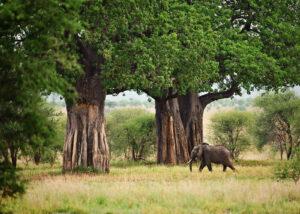Overview
Ruaha National Park is a national park located in Tanzania, East Africa. It is the largest national park in Tanzania and one of the largest in Africa. The park covers an area of about 20,226 square kilometers (7,809 square miles) in central Tanzania and is part of the larger Rungwa-Kizigo-Muhesi ecosystem.
Location: Ruaha National Park is situated in the southern part of Tanzania, and it is named after the Great Ruaha River, which runs through the park. The park is characterized by diverse landscapes, including rolling hills, mountains, and a wide variety of vegetation types. The Great Ruaha River is the lifeline of the park, providing water to a wide range of wildlife species.
Ruaha National Park is renowned for its rich and diverse wildlife. It is home to a wide variety of animals, including elephants, lions, leopards, cheetahs, wild dogs, giraffes, zebras, impalas, kudus, and many more. The park is known for its large elephant population.
The park is also a birdwatcher’s paradise, with over 570 bird species recorded, making it one of the top birding destinations in Tanzania.
Ruaha National Park features a mix of savannah, woodland, and riverine forests. The vegetation varies with the seasons, with lush greenery during the rainy season and drier landscapes during the dry season.
The Saba Game Reserve was established in 1910 by the German colonial government, and it was renamed the Rungwa Game Reserve by the British colonial authority in 1946. The reserve’s southernmost portion was designated a national park in 1964.
With a wide savannah, a river that draws an abundance of wildlife, and mountains to the west and south, Ruaha boasts a breathtaking and varied terrain. Rare animals such as leopards, cheetahs, and wild dogs can be found in Ruaha.
Where does Ruaha National park fit into my Tanzanian adventure?
In Tanzania’s northern safari circuit, Ruaha is frequently eclipsed by its bigger sisters. This is among its greatest advantages in a lot of ways.
Experience Tanzania’s natural beauty at Ruaha, free from the cacophony of nearby safari engines. What is so captivating about it is its absolute immensity and isolation. Ruaha is a stop on Tanzania’s southern safari circuit, which is frequently coupled with Selous.
Ruaha is home to Tanzania’s highest concentration of elephants, lions, and even crocodiles along the banks of the massive Ruaha River, despite the absence of rhinos.
Safaris at Ruaha.
The two most popular activities at Ruaha are walking safaris and early game drives. Vehicles cannot be driven at night.
You may get even closer to the wildlife by going on walking safaris with an expert ranger. Arriving only meters from a six-ton elephant is an incredible experience.
Wildlife photography chances abound on Ruaha safaris. The park can seem almost entirely to yourself because there are a lot less visitors than in the Serengeti or Ngorongoro.
Another fantastic option to see Ruaha National Park is by hot air balloon ride, which provides an amazing viewpoint of the surrounding area. Although these journeys are very costly (about US$550 per person), nothing compares to the thrill of soaring above East Africa’s vast plains, and it is well worth the money.
Wildlife at Ruaha.
With a population of about 10,000 of these gentle giants, Ruaha has the highest concentration of elephants in all of East Africa. Ten percent of the world’s lion population is in Ruaha.
Additionally, there’s a potential that you’ll spot jackals, elands, giraffes, impalas, bat-eared foxes, snakes, crocodiles, and leopards.
Ruaha is home to species from both Southern and Eastern Africa because of its peculiar location on the edge of Southern Africa. There are both greater and minor kudus at Ruaha. The lesser kudu is found in East Africa, while the greater kudu is typically found in Southern Africa.
Numerous endangered species can be found in Ruaha, including as the sable and roan antelopes.
on most areas, it is difficult to see cheetahs and leopards, but on the broad plains of Ruaha, they are frequently spotted hunting. Although there are only about 100 wild dogs in the park, they are threatened globally.
571 different bird species have been seen at Ruaha Park, making it a birdwatcher’s paradise. Acacias, baobabs, and more than 1,650 different plant species can be found dotting the stunning landscapes of Ruaha.
Cultural Tourism.
One of Tanzania’s biggest cities, Iringa, offers cultural tourism for those looking to escape the monotony of game drives.
Iringa has an interesting past, and its German colonial architecture is still evident today. More modern Tanzanian architecture has also influenced Ruaha, giving the city a genuine sense of Tanzanian village life.
Iringa is a fantastic spot to sample some street cuisine, purchase trinkets, and, with the assistance of a local guide, discover Tanzanian culture. The village boasts an intriguing prehistoric past, and Igeleke features breathtaking Iron Age rock art. It is now recognized as a protected cultural heritage site.
Even further back in time, from 1.5 million to 200,000 years ago, is the Isimila Stone Age Site. These websites are intriguing substitutes for displays regarding Tanzania’s colonial past and offer unique insights into prehistoric Tanzania.
Activities and Attractions.
Activities to do in the Ruaha National park
Visitors to Ruaha National Park can engage in activities such as game drives, walking safaris, and birdwatching. The park offers an excellent opportunity to observe wildlife in a more remote and less crowded setting compared to some of the more famous Tanzanian parks.
The park plays a crucial role in the conservation of the region’s biodiversity and is part of the larger Ruaha-Rungwa-Kizigo-Muhesi ecosystem, which helps protect a variety of wildlife species.
How To Get There & Best Time As Well As The Accommodation Options
Getting to Ruaha National park.
Due to its distant position, Ruaha is challenging to reach, but the reward for making the lengthy drive is the secluded safari paradise that lies ahead. There are fewer flights connecting to the Southern Safari Circuit because it is less well-known.
You can go to Ruaha by automobile or by plane, but for convenience and comfort, we suggest taking the former route. If you do choose to drive, you’ll get an amazing opportunity to see Tanzanian rural life up close and you may take in the ever changing, breathtaking scenery. You can even experience a bit of traditional rural life if you want to make a stopover in Morogoro or Iringa.
By road, it takes around nine hours to go 625 kilometers to Ruaha from Dar es Salaam. Iringa is about 130 kilometers distant, therefore you can simply drive there.
The trip takes much less time via plane. Flights to the local airstrips, Msembe and Jongomero, are regular from Dar es Salaam, Arusha, the Serengeti, Kigoma, and Dodoma.
Flying from Dar es Salaam are Coastal Aviation and Safari Airlink. One can request and reserve private flights.
When to visit Ruaha National Park?
Ruaha is best visited during the long dry season, which runs from June to October, like most other national parks in Tanzania. Compared to the hot, dry season, which runs from mid-December to mid-March, this time of year is comparatively chilly.
Because animals are lured to the diminishing water sources and the grass is too short for them to hide, the dry season also offers excellent viewing conditions for wildlife.
The greatest time to visit for bird aficionados is during the European winter, which runs from December to April, when migrating birds descend to Tanzania. When choosing your lodging, keep in mind that some lodges close from March to May during the lengthy, wet season.
.Accessibility:
The park can be accessed by road or by air. There are several lodges and camps within and around the park that offer accommodation for visitors.
Ruaha National Park is a relatively less-visited destination compared to some of Tanzania’s more famous parks like the Serengeti and Ngorongoro Crater, making it an excellent choice for travelers looking for a more remote and authentic safari experience. The park’s vast size and diverse wildlife make it a prime location for wildlife enthusiasts and photographers.
Accommodation in Ruaha National park.
Luxury lodges.
Jabali Ridge.
This opulent lodge, which is run by Asilia Africa, provides cozy, fashionable lodging. During the dry season, guests at the resort can enjoy fantastic views of elephants and buffalo across the Mwagusi River. For those who like their privacy, Jabali provides 8 suites, including the Jabali Private House. In addition, the resort has an infinity pool, hammocks, and a hot stone massage spa.
Jongomero Camp:
This camp is perfectly situated to fit in with its breathtaking surroundings. It is located on the banks of the seasonal Jongomero River, which serves as a vital water source for numerous wildlife species. Reclaimed dhow wood is used to build the furniture in the restaurant and bar, which are located on an open wood terrace.
Kichaka Expeditions.
Select from three environmentally friendly camps that blend luxury and rustic charm. Kichaka takes great pleasure in the isolated surroundings of its camps, which are situated deep within the woods. Kichaka Expeditions’ headquarters are located at Kichaka Frontier.
Mid-range lodges.
Kwihala Camp.
This solar-powered camp, which is also run by Asilia Africa, has six roomy tents. Msembe Airstrip may be reached by car in around 45 minutes from the expedition-style camp. The ideal way to round off an exciting day at Ruaha is with an evening beverage by the campfire.
Nomad Kigelia Camp:
Located east of Ruaha, this modest jungle camp features six roomy tents, a family tent with two rooms, and an inside and outdoor dining option. There is a bush breakfast provided, and bush walks are an additional charge.
Ruaha River Lodge:
This lodge is in an excellent site, perched on a bend in the Great Ruaha River. There are 24 stone-built cabins at the resort, each with an own veranda that provides breathtaking views of the fauna of Ruaha. The eating area is divided between two locations: a banda beside the river and a banda atop a hill that provides expansive views over the Great Ruaha River.
Mwagusi Camp:
At the park, this camp is the oldest, having been constructed in 1987. Wood, driftwood, and grass thatch make up the majority of the natural materials used to construct the camp. Situated beneath a thatched roof, each banda has a roomy and spacious tent. A community-based organization that has done vital conservation
work in the area, the Foxes’ Community and Wildlife Conservation Trust (FCWCT), is supported by the camp.
Budget lodges.
Mdonya Old River Camp:
There are twelve Meru-style tents available at this budget camp. The camp takes pleasure in maintaining safari staples like outside showers and is practical yet cozy.
Request Quote
Fill in and send the safari request form, we shall respond as soon as we receive your message. You can also reach us on Whats-app Number: +256753750983 for urgent requests.

